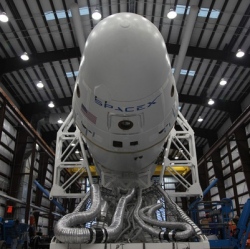
A SpaceX Falcon 9 rocket has launched from Florida to put the Deep Space Climate Observatory (DSCOVR) in orbit. The satellite will be used by the US National Oceanic and Atmospheric Administration to monitor the Sun. It will provide details on space weather and warnings on hazardous outbursts from our star.
The Sun can hurl vast clouds of charged particles and radiation towards Earth, disrupting a range of critical services from GPS to electricity distribution. "DSCOVR will serve as our ‘tsunami buoy in space’, if you will, giving forecasters up to an hour’s warning on the arrival of the huge magnetic eruptions from the Sun that occasionally occur called Coronal Mass Ejections (CMEs)," explained Tom Berger, the director of Noaa’s Space Weather Prediction Center in Boulder, Colorado.
"CMEs are the cause of the largest geomagnetic storms at Earth, some of which can severely disrupt our technological society, causing loss of communications with aircraft, particularly those flying over the poles; damage to satellites in orbit; and even damage to power grid equipment on the ground."
DSCOVR, operating from a point in space 1.5 million km nearer to our star, will succeed the capability provided by the Advanced Composition Explorer, or Ace satellite, for the past 17 years. The satellite’s Falcon 9 rocket left the pad at Cape Canaveral at 18:03 local time (23:03 GMT) on Wednesday. It was actually the third attempt at a lift-off. Problems with an Air Force tracking radar and poor weather conditions had previously forced the postponement of the flight.
In addition to launching DSCOVR, the SpaceX company intended to use Wednesday’s flight to test once again the technology for recovering the first-stage – or lower segment – of its Falcon rocket. The idea is to re-light the engines on the booster after its ascent and separation, and then fly it back under control to land on a floating platform in the Atlantic.
In the previous experiment in January, the stage successfully found the platform but exploded on impact. Wednesday’s mission had to abandon the drone landing because of a big swell, but engineers still used the occasion to bring the booster to a hovering stop over the water where the vessel would have been.
SpaceX CEO, Elon Musk, later tweeted: "Rocket soft landed in the ocean within 10m of target & nicely vertical! High probability of good droneship landing in non-stormy weather." The rocket company says that if it can recycle its rockets, it should be able to offer much lower prices for launches.
